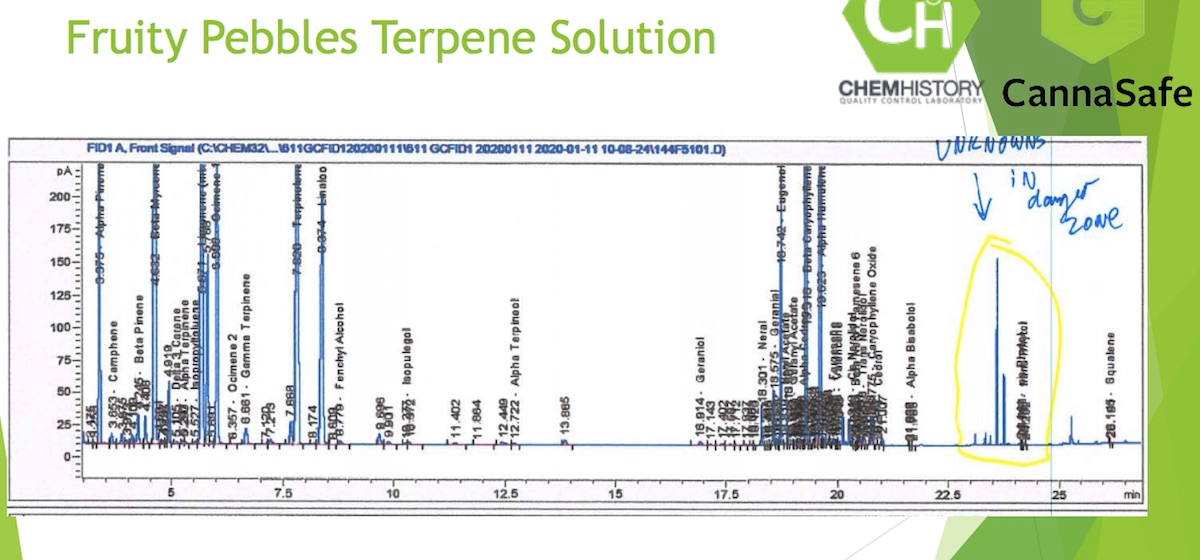The Oregon Liquor Control Commission (which oversees cannabis) is moving to ban additives like artificial ‘grape ape’ flavor in legal THC vapes. The action comes this month after a report found that 23 state residents got sick and two died of vaping associated pulmonary injury (VAPI) between June and December of 2019.
Oregon’s move comes as a reminder that one year after the first reports of VAPI, the issue of tainted vapes has not gone away. A wide variety of chemical cutting agents may contaminate vape cartridges. The overwhelming majority of them are in the illicit market, where’s there’s no testing. However, confirmed tainted vapes have popped up in legal states Michigan, and Oregon.
Some Oregon THC vapers have been inhaling not only flavoring but what amounts to burnt olive oil—a substance called “squalene” that can cause lipid pneumonia. Evidence of squalene turned up in four independent lab reports, which were published at the OLCC’s technical expert advisory meeting on July 27.
Scientists at the FDA Forensic Chemical Center found squalene—which can also be derived from shark liver oil—in at least one legal cannabis product. The Centers for Disease Control tested another seven legal cannabis items associated with VAPI cases, and detected squalene in all seven.
By contrast, New York’s illicit market THC vapers last year were inhaling not one but two toxic oils—vitamin E acetate and squalene—according to lab reports presented at the OLCC meeting.
The list of adulterants in the Oregon market didn’t stop at squalene. By vaping artificial flavorings, THC vapers may have been inhaling “a plethora of dangerous compounds” not listed on the label, experts told the OLCC. Oregon labs ChemHistory and CannaSafe tested five popular artificial flavorings and found undisclosed safety hazards in all of them: vitamin E acetate and vitamin E, but also MCT oil (coconut oil), squalene, and bisabolene.
The new Oregon rule would prohibit any “inhalable cannabinoid product” from containing non-cannabis-derived substances, including flavors, non-cannabis terpenes, and/or chemicals that alter a legal THC product’s “consistency, texture, or viscosity.”
The non-cannabis ingredient ban seems likely to pass later this month.
VAPI/EVALI epidemic explained
From 2019 through this year, Leafly has investigated the decade-old, simmering issue of contaminated vapes. That controversy finally boiled over in August 2019, turning into a national mass injury series—not an ‘epidemic’— that killed 68 people and sickened 2,803 others.
Leafly found negligent vape-additive sellers who diverted a variety of cosmetics and dietary supplement ingredients into the nation’s mostly illicit THC vape supply chain.
Our news team called industry experts, then went out and purchased, and tested suspected vape carts, and additives. Our labs identified vitamin E acetate as the lead culprit among a gang of toxins injuring American lungs. Those toxins still exist in the street’s THC vape supply, albeit at lower potencies than in 2020.
Safe to eat, not to huff
Last summer’s VAPI outbreak was caused largely by illicit vape cart manufacturers looking to lower costs and increase profits by using thinning agents that actually “thickened” the look of the cartridge oil—deceiving consumers into believing the carts contained more THC than they actually did.
But thickeners weren’t the only contaminants. Some cartridges contained artificial flavorings that mimicked the aroma molecules of cannabis, which are called terpenes. These fake terpenes often promise tastes like fruity pebbles, bubble gum, or grape.
While flavors are generally recognized as safe (GRAS) for eating, it’s “false and misleading” to suggest they’re safe to inhale, according to a July 24, 2020, statement by the Flavor and Extract Makers Association.
What is squalene? And why is it in a legal Oregon vape?
Squalene is essentially a skin cream ingredient being misused to cut vape flavors or raw THC oil.
Squalene can also be extracted from olive oil, which allows third-party producers to label the oil “botanically derived.”
The manufacturer’s safety data sheet for squalene includes a warning not to breathe it. The same data sheet advises anyone nearby to wear a respirator if it’s on fire. So think about what’s happening inside a vape pen that heats the oil up to several hundred degrees.
Squalene is associated with exogenous lipoid pneumonia—one of the many indicators of VAPI.
Terpene sellers were coy
ChemHistory Technical Director Patrick Trujillo told regulators that terpene makers have been “coy” about exactly what’s in the runny, clear, smelly liquids. Manufacturers claim the chemical makeup of their mixture is “proprietary” and “labs can only guess at what isn’t listed on the label.”
So ChemHistory of Milwaukie, OR, bought five “commercially available products off the internet from sites commonly used by the recreational system,” Trujillo said.
In solutions listed as containing or mimicking the tastes of myrcene, Fruity Pebbles, and geraniol, Trujillo expected to find the “truly nasty stuff”—vitamin E.


Instead, he found “massive peaks of unknowns” with troubling characteristics. The solutions boiled only at high temperatures. They were heavy molecules that got deep into the lung, and they were in a “risky area” on the gas chromatograph, close to MCT oil, vitamin E, and squalene.
Some manufacturers of popular terpenes like limonene and myrcene may advertise them as 99% pure, but that 1% can have all sorts of other things in it, Trujillo said.

Squalene on the West Coast, vitamin E on the East Coast
ChemHistory’s results both align with and add to our understanding of lab results from the New York Department of Health, the FDA’s Forensic Chemistry Center, and findings from the CDC.
We know now that drug dealers who cut cocaine with baby aspirin, or heroin with fentanyl, will cut THC vape oil with beard cream. It’s a way to boost profits at the expense of customer safety.
In New York, state public health sleuths took samples from VAPI victims and tested their disposable vape cartridges. When they found evidence of vitamin E, they “became aware of the internet lore and an on-line cannabis diluent industry, with numerous cannabis oil diluents available for purchase,” their report states.
Then, New York health officials purchased and tested six diluent thickeners from MassTerpenes, Floraplex’s Uber Thick, and Honey Cut. “Three of the products were found to be essentially pure vitamin E acetate,” the July 23, 2020, report states.
Colorless, odorless, impossible to distinguish
“[Vitamin E acetate]-based diluents were touted as tasteless and odorless thickeners that are miscible with cannabis oil in all proportions and produce a desirable cloud on vaping. Upon visual inspection, it is nearly impossible to distinguish between a cartridge containing high-grade cannabis oil and one heavily cut with [Vitamin E acetate],” wrote David Spink, Ph.D., NYDOH Deputy Director of the Division of Environmental Health Sciences.
“Two other products were found to be primarily squalane,” the report states. “Another product is primarily α-bisabolol.”
Lung and chemical experts say this stuff is at least “probably bad,” and potentially “highly toxic.”
Spink’s team found a “strong correlation” between VAPI and the use of at least one cannabis vaporizer cartridge containing vitamin E acetate [VEA]. “The illicit vaporizer fluids associated with VAPI cases can be characterized as heavily cut with diluents, most notably VEA,” they concluded.
In some cases the vape injury looks like lipoid pneumonia; in or other cases it can present as a chemical burn.
Lipoid pneumonia can be caused by huffing oil-based substances like mineral oil, squalene, Vaseline, olive oil, sunflower oil, and liquid paraffin, experts state. And vitamin E acetate “has similar chemical and physical properties to compounds such as white mineral oil that are known to cause lipoid pneumonia,” New York reports.
A 2020 FDA study in mice replicated vitamin E vaping lung injury by exposing 30 animals to different aerosols or pure air over two weeks and then examining their lung tissue. The lab study recreated hallmarks of VAPI, like lung liner damage, and immune cells gunked up with oil, called ‘lipid-laden macrophages.’
“It is possible that VEA is causative or contributes to the development of lipoid pneumonia,” Spink concludes. “There is no evidence that vaping large quantities of compounds such as VEA is safe for human health.”
More than vitamin E acetate injuries
The OLCC meeting reports confirm what Leafly published beginning in August of 2019 through February 2020—that vitamin E might be a major culprit, but there are also secondary and tertiary toxins, or their heated byproducts, that can injure the lungs, at lower amounts, in lower levels, over longer periods of time.
Even small amounts of vitamin E can be heated to form “highly toxic” ethenone, according to Oregon Deputy State Epidemiologist Dr. Ali Hamade, and Portland State University Department of Chemistry Professor Dr. Robert Strongin. They told the OLCC that ethenone is similar to chemical warfare agents ketene and phosgene; all you need is 12 parts per million of the stuff to get a lethal, slow-onset blistering of lung tissue.
Ketene is also hard to detect because it’s so reactive.
“You’ll never find it in [lung fluid], it reacts with the first thing it sees,” Strongin said.
“Ketene is terrible stuff,” and it’s “very plausible” ketene has injured unsuspecting vapers, he said.
The naughty list is long
Also on the naughty list: the whole class of heavy, oily cutting agents—MCT oil, pine rosin, the variations are endless. They’re all used to secretly dilute raw THC oil or a terpene mix.
The legal cannabis industry, and traditional cannabis culture, have generally resisted using non-cannabis ingredients in cannabis products, especially inhaled ones, PSU chemistry professor Strongin told the OLCC. Rather, e-cigarette makers championed the diversion of food flavors and cosmetics made for the stomach and skin into millions of human lungs.
“The last thing I want to do is hurt anybody’s industry or company,” Strongin said. However, “there are probably 10,000 products for different flavors or mixtures of the same chemical. Wouldn’t you think that the odds are that eventually, somebody is going to create some formulation that is going to make people really sick since the inhalation toxicity is not known? It was a matter of time.”
By contrast, “cannabis has been smoked for thousands of years–but there were no known instances of EVALI until relatively very recently. Why?” Strongin said.
What took the OLCC so long?
OLCC Director of Analytics & Research TJ Sheehy told Leafly that Oregon is moving as fast as it scientifically can to clamp down on unlisted toxins. In 2019, when the OLCC implemented an emergency ban, vape flavor sellers challenged the move in court and won an injunction halting the ban.
Federal cannabis prohibition also slowed the process, Sheehy said. Because it’s so legally problematic to handle cannabis, too few labs are set up to study cannabis vaping, novel additives, aerosol generation, lung deposition, and pyrolytic byproducts—especially highly volatile ones like ketene. “I think everything waterfalls off of that main problem,” Sheehy said.
In response, the OLCC hopes to beef up in-state lab capabilities to better scout for the next vitamin E or squalene.
Killer still on the lose
The CDC stopped tracking VAPI deaths in February as the coronavirus epidemic eclipsed the issue. But sporadic vape injuries continue to be reported this summer.
Up until Monday, anyone with a credit card and a physical address could import up to $800 of vitamin E acetate cutting agent, and counterfeit vape brand packaging from an overseas seller, and pay no tax, with minimal documentation, the Wall Street Journal reported Aug. 3. If you ordered by Sunday, you could be selling toxic counterfeit vapes on social media by mid-month.
Leafly still gets weekly text message pictures of counterfeit packaging for sale in downtown L.A.—any of it could fool a consumer.
“The nature of the problem is not one that goes away on its own,” Sheehy said. “It really is whack-a-mole. Once vitamin E is named and shamed it goes to something else.
What is a consumer to do?
Toxic adulterants can be avoided if consumers follow a few rules of thumb.
Avoid illicit THC vapes entirely. Online counterfeits of popular brands are rampant, so just because it looks like a Rove and your buddy says he got it from a cousin who got it in a legal state does not mean it actually is one. Shop only in legal stores with posted license numbers verified by the state.
Buy legal vapes that contain only cannabis ingredients. Watch out for questionable, vague ingredients like: “natural flavors” or “botanically derived terpenes.” Derived from what? By whom? When? Sold by whom? At what purity?
Vapes are just a small fraction of legal cannabis options. Fast-acting alternatives can include vaping regular cannabis flowers in a device like a Pax 3, just smoking flowers in a joint or pipe, or extracts like bubble hash or rosin, as well edibles, drinks, topicals, tinctures, transdermals and more.
Article Originally Featured:
on: Leafly
by: David Downs
August 4th, 2020








